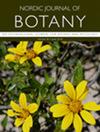Successful restoration of alpine plant communities depends on habitat type
IF 1.1
4区 生物学
Q3 PLANT SCIENCES
引用次数: 0
Abstract
Alpine ecosystems are under increasing pressure from land‐use change and road construction, resulting in habitat fragmentation and declines in biodiversity and ecosystem function. Ecosystem restoration can mitigate the impacts from human land‐use change by assisting the recovery of natural ecosystems. We developed an assessment framework using established international standards and monitored alpine vegetation recovery within restored zones along a hydropower‐dam road built in 2013 in the Knutshø landscape protected area, Norway. Using data collected in 2016, 2018 and 2021, we compared abiotic variables and vegetation indicators (cover, and community composition) in restored zones against directly adjacent intact zones within three different habitat types. After eight years, wetland habitat had similar cover of plant functional types and abiotic variables within restored and intact zones, while ridge and willow‐heath habitats had more cover of graminoids and less cover of shrubs in restored compared to intact zones. In addition, community composition in restored wetland habitat zones was similar to intact zones, while the community composition of restored zones in ridge and willow‐heath habitats was significantly different from adjacent intact zones. This suggests that restored wetland habitat in our study system is on a trajectory of recovery, but that recovery of other plant community types may require longer periods of time or, in some cases, may not be possible without further intervention because of alternative stable states. Our results underscore the need for long‐term monitoring and adaptive management to insure restoration success in alpine environments.成功恢复高山植物群落取决于生境类型
阿尔卑斯山生态系统正承受着土地使用变化和道路建设带来的越来越大的压力,导致栖息地破碎化、生物多样性和生态系统功能下降。生态系统恢复可以帮助自然生态系统的恢复,从而减轻人类土地使用变化带来的影响。我们采用既定的国际标准制定了一个评估框架,并对挪威克努特肖景观保护区内一条建于 2013 年的水电站-水坝公路沿线恢复区内的高山植被恢复情况进行了监测。利用 2016 年、2018 年和 2021 年收集的数据,我们比较了三种不同生境类型中恢复区与直接相邻的完整区的非生物变量和植被指标(覆盖度和群落组成)。八年后,湿地栖息地的植物功能类型覆盖率和非生物变量在恢复区和完好区相似,而山脊和柳杉栖息地的禾本科覆盖率在恢复区高于完好区,灌木覆盖率低于完好区。此外,湿地生境恢复区的群落组成与完好区相似,而山脊和柳杉生境恢复区的群落组成与邻近完好区有显著差异。这表明,在我们的研究系统中,恢复后的湿地生境正处于恢复的轨道上,但其他植物群落类型的恢复可能需要更长的时间,或者在某些情况下,由于存在其他稳定状态,如果不采取进一步的干预措施,可能就无法恢复。我们的研究结果强调了长期监测和适应性管理的必要性,以确保在高山环境中恢复的成功。
本文章由计算机程序翻译,如有差异,请以英文原文为准。
求助全文
约1分钟内获得全文
求助全文
来源期刊

Nordic Journal of Botany
生物-植物科学
CiteScore
1.90
自引率
11.10%
发文量
100
审稿时长
2 months
期刊介绍:
Nordic Journal of Botany publishes original contributions on all aspects of the taxonomy, evolution, conservation, ecology and biogeography of plants (including algae and bryophytes) and fungi.
 求助内容:
求助内容: 应助结果提醒方式:
应助结果提醒方式:


